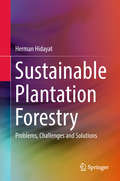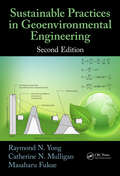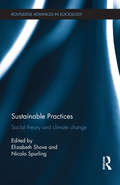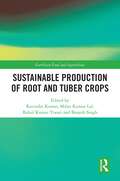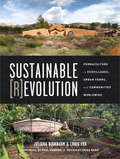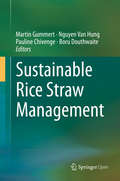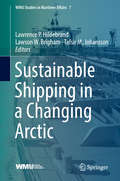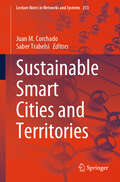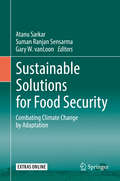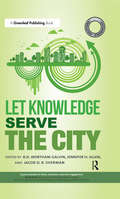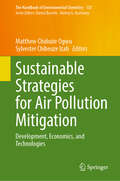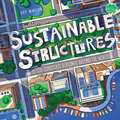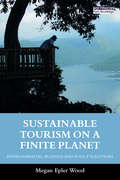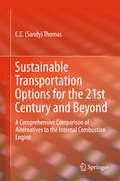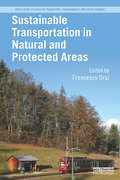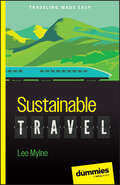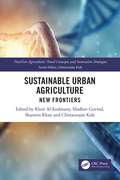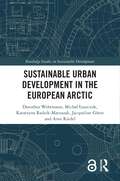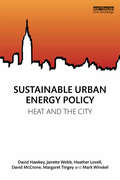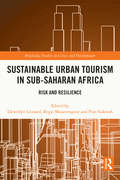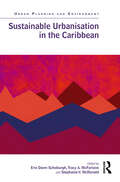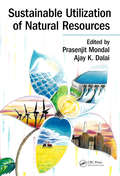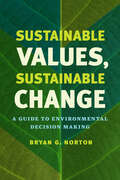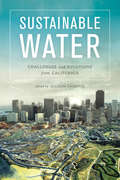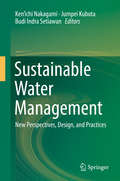- Table View
- List View
Sustainable Plantation Forestry: Problems, Challenges And Solutions
by Herman HidayatThis book discusses sustainable forest management from the perspectives of sociology, anthropology, politics, economics and policy. It examines the roles of governments, private sectors, NGOs, academics and local communities in implementing sustainable plantation forestry, which aims to supply timber for the forestry industry while at the same time reducing global warming. The book also explores the debates on sustainable forest management practices in several countries, and examines the effects of political ecology on plantation forestry as well as the impact of climate change and conservation programs. By analyzing a number of interrelated issues, it offers a valuable resource for all governments, private companies, practitioners, NGOs, academics and students studying forest management and political ecology from a social sciences perspective.
Sustainable Practices in Geoenvironmental Engineering
by Raymond N. Yong Catherine N. Mulligan Masaharu FukueIn the seven years since the publication of the first edition of Sustainable Practices in Geoenvironmental Engineering, the combination of population growth and increased exploitation of renewable and non-renewable natural resources has added increased stresses on the quality and health of the geoenvironment. This is especially true when viewed in
Sustainable Practices: Social Theory and Climate Change (Routledge Advances in Sociology)
by Elizabeth Shove Nicola SpurlingClimate change is widely agreed to be one the greatest challenges facing society today. Mitigating and adapting to it is certain to require new ways of living. Thus far efforts to promote less resource-intensive habits and routines have centred on typically limited understandings of individual agency, choice and change. This book shows how much more the social sciences have to offer. The contributors to Sustainable Practices: Social Theory and Climate Change come from different disciplines – sociology, geography, economics and philosophy – but are alike in taking social theories of practice as a common point of reference. This volume explores questions which arise from this distinctive and fresh approach: how do practices and material elements circulate and intersect? how do complex infrastructures and systems form and break apart? how does the reproduction of social practice sustain related patterns of inequality and injustice? This collection shows how social theories of practice can help us understand what societal transitions towards sustainability might involve, and how they might be achieved. It will be of interest to students and researchers in sociology, environmental studies, geography, philosophy and economics, and to policy makers and advisors working in this field.
Sustainable Production of Root and Tuber Crops (Earthscan Food and Agriculture)
by Ravinder Kumar Brajesh Singh Milan Kumar Lal Rahul Kumar TiwariThis book provides a comprehensive overview of the latest research and developments in the field of root and tuber crops from a sustainable production and protection perspective.With a focus on sustainable production methods, the book offers valuable insights and perspectives on how to improve the efficiency and sustainability of root and tuber crop production. This is particularly important given the increasing demand for food security and sustainable agriculture practices globally. The chapters focus on a wide range of production strategies, including soil, nutrient dynamics, nutrient management, fertilizer consumption, and cropping systems, as well as the use of modern farming techniques and technologies. With seed production and supply chains playing critical roles in cash crops like potatoes, a staple food in many countries, the volume also covers healthy seed planting material, low-cost technological intervention for quality seed production, integrated weed management for local and global perspectives, and enhancing the efficiency of small-holder farmers in the Global South. Finally, this book considers the challenges posed by pests and disease management. It describes management methods, as well as the distribution, symptoms and damage, biology, survival, and spread of each pest, and also discusses various environmentally friendly pest management strategies, such as physical, cultural, chemical, biological, host resistance, and integrated methods.This book will be of interest to students and scholars of sustainable agriculture, crop management, and plant sciences.
Sustainable Revolution
by Paul Hawken Louis Fox Juliana Birnbaum Erika RandUrban gardeners. Native seed-saving collectives. Ecovillage developments. What is the connection between these seemingly disparate groups? The ecological design system of permaculture is the common thread that weaves them into a powerful, potentially revolutionary--or reevolutionary--movement. Permaculture is a philosophy based on common ethics of sustainable cultures throughout history that have designed settlements according to nature's patterns and lived within its bounds. As a movement that has been building momentum for the past 40 years, it now is taking form as a growing network of sites developed with the intention of regenerating local ecologies and economies. Permaculture strategies can be used by individuals, groups, or nations to address basic human needs such as food, water, energy, and housing. As a species, humans are being called forth to evolve, using our collective intelligence to meet the challenges of the future. Yet if we are to survive our collective planetary crisis, we need to revisit history, integrating successful systems from sustainable cultures. To boldly confront our position on the brink of the earth's carrying capacity and make changes that incorporate the wisdom of the past is truly revolutionary. Sustainable Revolution features the work of a worldwide network of visionaries, including journalists, activists, indigenous leaders and permaculturists such as David Holmgren, Vandana Shiva, Charles Eisenstein, Starhawk, Erik Assadourian, Victoria Tauli-Corpuz, Albert Bates, and Geoff Lawton. This beautifully photographed collection of profiles, interviews, and essays features 60 innovative community-based projects in diverse climates across the planet. Edited by anthropologist Juliana Birnbaum Fox and award-winning activist filmmaker Louis Fox, it can be read as an informal ethnography of an international culture that is modeling solutions on the cutting edge of social and environmental change. The research presented in the book frames the permaculture movement as a significant ally to marginalized groups, such as the urban poor and native communities resisting the pressures of globalization. Sustainable Revolution uplifts and inspires with its amazing array of dynamic activists and thriving, vibrant communities.From the Trade Paperback edition.
Sustainable Rice Straw Management
by Martin Gummert Nguyen Van Hung Pauline Chivenge Boru DouthwaiteThis open access book on straw management aims to provide a wide array of options for rice straw management that are potentially more sustainable, environmental, and profitable compared to current practice. The book is authored by expert researchers, engineers and innovators working on a range of straw management options with case studies from Vietnam, the Philippines and Cambodia. The book is written for engineers and researchers in order to provide them information on current good practice and the gaps and constraints that require further research and innovation. The book is also aimed at extension workers and farmers to help them decide on the best alternative straw management options in their area by presenting both the technological options as well as the value chains and business models required to make them work. The book will also be useful for policy makers, required by public opinion to reduce greenhouse gas emissions and air pollution, looking for research-based evidence to guide the policies they develop and implement.
Sustainable Shipping in a Changing Arctic (WMU Studies in Maritime Affairs #7)
by Lawrence P. Hildebrand Lawson W. Brigham Tafsir M. JohanssonThis volume brings together multiple perspectives on both the changing Arctic environment and the challenges and opportunities it presents for the shipping sector. It argues for the adoption of a forward-looking agenda that respects the fragile and changing Arctic frontier. With the accelerated interest in and potential for new maritime trade routes, commercial transportation and natural resource development, the pressures on the changing Arctic marine environment will only increase. The International Maritime Organization Polar Code is an important step toward Arctic stewardship. This new volume serves as an important guide to this rapidly developing agenda. Addressing a range of aspects, it offers a valuable resource for academics, practitioners, environmentalists and affected authorities in the shipping industry alike.
Sustainable Smart Cities and Territories (Lecture Notes in Networks and Systems #253)
by Juan M. Corchado Saber TrabelsiThis book constitutes the proceedings of this year’s Sustainable Smart Cities and Territories International Conference (SSCt 2021), held in Doha, Qatar, from the 27th to the 29th of April 2021. The SSCt 2021 is an open symposium that brings together researchers and developers from academia and industry to present and discuss the latest scientific and technical advances in the fields of Smart Cities and Smart Territories. It promotes an environment for discussion on how techniques, methods, and tools help system designers accomplish the transition from the current cities towards those we need in a changing world. The program includes keynote abstracts, a main technical track, two workshops, and a doctoral consortium. The symposium is organized by the Texas A&M University at Qatar. We would like to thank all the contributing authors, the members of the Local Committee, Scientific Committee, Organizing Committee, and the sponsors (Texas A&M University of Qatar, AIR Institute and the IoT Digital Innovation Hub) for their hard work and dedication.
Sustainable Solutions for Food Security: Combating Climate Change by Adaptation
by Atanu Sarkar Suman Ranjan Sensarma Gary W. VanLoonThis volume is the first centralized source of technological and policy solutions for sustainable agriculture and food systems resilience in the face of climate change. The editors have compiled a comprehensive collection of the latest tested, replicable green technologies and approaches for food security, including smart crops and new agricultural paradigms, sustainable natural resources management, and strategies for risk assessment and governance. Studies from resource-constrained countries with vulnerable populations are emphasized, with contributions on multisector partnership from development professionals. Debates concerning access to climate-smart technologies, intellectual property rights, and international negotiations on technology transfer are also included. The editors are, respectively, a public health physician, a development professional and an environmental scientist. They bring their varied perspectives together to curate a holistic volume that will be useful for policy makers, scientists, community-based organizations, international organizations and researchers across the world.
Sustainable Solutions: Let Knowledge Serve the City
by B.D. Wortham-Galvin Jennifer H. Allen Jacob D.B. ShermanPortland, Oregon. Sustainability might not seem glamourous, but Portland is making a name for itself as one of the most sustainable cities in the world. Whether you’ve heard about the farmers’ markets, the cycle-friendly streets or the ongoing efforts to balance livability and equity, Portland is leading the way in urban sustainability: this book helps us understand how it achieves this.A critical component of Portland’s success is collaboration between different communities and institutions; the Sustainable Solutions series examines higher education’s role in these partnerships. In exploring how best to “let knowledge serve the city”, Portland State University translates its founding motto from mere words to applied research and action.This first volume examines different approaches to collaborative work that PSU has taken, both within the university and with community partners: how have barriers been overcome between different areas of study, between academia and the public, and why is bridging these divides so important? It also introduces the themes of the engaged university, social justice, climate change and sustainable economic development, which shape PSU’s work.Let Knowledge Serve the City is ideal for anyone seeking best practice in connecting students and universities with the needs of local communities. From public interest design and student leadership, to food justice and age-friendly development, authors combine academically rigorous theories of sustainability and community-university partnerships with lessons learned on how to realize ideals of sustainable development.
Sustainable Strategies for Air Pollution Mitigation: Development, Economics, and Technologies (The Handbook of Environmental Chemistry #133)
by Matthew Chidozie Ogwu Sylvester Chibeuze IzahThis book reviews air pollution, discussing its far-reaching impacts and presenting sustainable strategies to effectively address and mitigate these challenges. The book explores how addressing air pollution is in alignment with the United Nations Sustainable Development Goals, specifically SDG 3 (Good Health and Well-being), SDG 11 (Sustainable Cities and Communities), and SDG 13 (Climate Action). In this book, readers will find in-depth discussions on the effects of air pollution on human health, ecosystems, and the environment, underscoring the urgent need for effective mitigation strategies and the critical role of air pollution in driving climate change. The book also examines the economic impacts of air pollution and the disproportionate burden it places on vulnerable populations, emphasizing the importance of equitable public health policies and the necessity of social justice in pollution control efforts. Furthermore, this work presents sustainable strategies for managing air quality, stressing their significance for both human health and climate benefits. It provides an authoritative analysis of the policies and regulations crucial to achieving clean air, highlighting their role in reducing the adverse effects of air pollution on public health. Special attention is given to the latest technologies and innovations designed to mitigate air pollution. Together with its companion volume, "Air Pollutants in the Context of the One Health Approach: Fundamentals, Sources, and Impacts," this book serves as an essential resource for researchers, policymakers, students, and all those dedicated to tackling the complex challenges posed by air pollution and its far-reaching consequences for human health, the environment, and global sustainability.
Sustainable Structures: 15 Eco-Conscious Buildings Around the World (Books for a Better Earth)
by Kate McMillanA stunning illustrated overview of &“green&” architecture on every continent, packed full of cool STEAM facts and fascinating details.From a waste collection site built entirely from recycled materials, to a school designed to float during flood season in Bangladesh, this dazzling book highlights innovative and sustainably built structures around the world. Did you know that &“woodscrapers,&” or skyscrapers made of wood, can reduce construction waste? How about that termite mounds have served as inspiration for temperature control systems? And believe it or not… there&’s a research station built on skis in Antarctica.Pairing a kid friendly, conversational approach with spectacularly detailed art, Kate McMillan dissects the design of 15 eco-friendly buildings worldwide. The extraordinary structures fall into five categories, each emphasizing a key element of sustainable design: 1) local materials, 2) adaptability, 3) sustainable construction, 4) clean energy, and 5) optimized space. Readers of all ages will love poring over the precise, colorful illustrations and informative close ups featured on eye catching double-page spreads. Perfect for budding architects and engineers, this book is a work of art!Books for a Better Earth™ are designed to inspire children to become active, knowledgeable participants in caring for the planet they live on.A Junior Library Guild Gold Standard Selection
Sustainable Tourism on a Finite Planet: Environmental, Business and Policy Solutions
by Megan Epler WoodThis book helps all those involved in international tourism develop the new skills, tools and investments required to protect irreplaceable global resources from the impacts of escalating tourism demand over the next 50 years. It documents how technology and the growing global middle class are driving a travel revolution which requires a new paradigm in managing tourism destinations. Travel and tourism supply chains and business models for hotels, tour operators, cruise lines, airlines and airports are analysed and environmental management techniques are proposed for each sector. A pragmatic set of solutions are offered to support the transition to lower impact tourism development worldwide. It recommends that decision makers assess the current and future value of natural, social, and cultural capital to guide investment in destinations and protect vital resources. Case studies illustrate why budgets to protect local destinations are consistently underestimated and offer guidance on new metrics. Innovative approaches are proposed to support the transition to green infrastructure, protect incomparable landscapes, and engage local people in the monitoring of vital indicators to protect local resources. It provides students, professionals, and policy makers with far-reaching recommendations for new educational programs, professional expertise, financing, and legal frameworks to lower tourism’s rapidly escalating carbon impacts and protect the health and well-being of local populations, ecosystems, cultures, and monuments worldwide.
Sustainable Transportation Options for the 21st Century and Beyond
by C. E. Sandy ThomasThis book includes an in-depth analysis of the environmental and energy security impacts of replacing the internal combustion engine vehicle with various forms of electric vehicles and replacing gasoline and diesel fuel with alternative fuels including electricity, hydrogen and biofuels. In addition to a detailed "well-to-wheels" analysis of local air pollution, greenhouse gas emissions and oil consumption for each alternative vehicle, the book estimates the market penetration potential of each fuel/vehicle combination to determine the most likely societal impact of each alternative vehicle pathway. To support the market penetration estimates, the book analyses the likely cost of each alternative vehicle in mass production and the cost of installing the necessary fuel infrastructure to support each option. The book provides sufficient detail to allow decision makers in governments and industry to choose among the alternative vehicle/fuel combinations that will lead to a truly sustainable transportation system.
Sustainable Transportation in Natural and Protected Areas (Routledge Studies in Transport, Environment and Development)
by Francesco OrsiProtected areas are at the centre of nature-based tourism, which is increasingly popular across the world. As visitor numbers increase, so does awareness of the harmful effects that large crowds may have on both natural resources and individuals’ recreational experience. This volume considers the challenge of transportation to and within natural and protected areas, the improvement of which has already been recognised as having great potential for mitigating the environmental impacts of ecotourism. While several books have focused considerable attention to the management of protected areas in general, little has been said about the specific issue of sustainable transport, an emerging trend that is already reshaping visitation patterns in natural settings. This book provides current knowledge on issues associated with the transportation of visitors in natural and protected areas, and a comprehensive overview of the technical and strategic options available to tackle these issues. It approaches the subject via three main topics: preferences, or the visitors' attitudes towards transportation; practices, where current approaches are assessed through examples and case-studies of successful experiences and methodologies from around the world; and policies, where suggestions and recommendations are put forward for both local scale strategies and broad-scale regulatory action with global relevance. Contributors include academics in the field of natural resource management and tourism, with extensive experience in protected area management and active partnerships with natural park administrations.
Sustainable Travel For Dummies
by Lee MylneHow to travel lightly across planet Earth Sustainable Travel For Dummies is for travelers of all ages and budgets who want to reduce their carbon footprints, respect and protect the planet, contribute to local economies, and incorporate conservation into their travel experiences. That’s you! This easy-to-read guide shows you what sustainable travel is, why it’s important, and how to do it—with no travel shaming. Award-winning travel journalist Lee Mylne brings a global perspective on fun ways to travel responsibly. A must-have resource for globetrotters and for those whose travels keep them close to home, this book covers alternative transportation, unique accommodations, fulfilling cultural experiences, everything else the eco-savvy traveler needs to know. Discover how to plan eco-friendly trips to destinations near and far Reduce your carbon footprint while still enjoying life-affirming experiences Learn about alternative methods of transportation and sustainable accommodations Gain cultural awareness and get fun ideas for making the most of your travel Sustainable Travel For Dummies is an inspiring read for travelers who are new to sustainable and ethical travel and seeking practical tips for eco-conscious wandering.
Sustainable Urban Agriculture: New Frontiers (Nextgen Agriculture)
by Chittaranjan Kole Kheir Al-Kodmany Sharmin Khan Madhav GovindIn the vibrant discourse of urbanization and climate change, Sustainable Urban Agriculture: New Frontiers investigates emerging needs, rising challenges, and opportunities to support urban agriculture. Navigating the dynamic interplay of urbanization and environmental challenges, the book introduces two pivotal agendas for urban sustainability—the "green" agenda, focusing on environmental health, and the "brown" agenda, emphasizing human well-being and social justice. The book embraces a global perspective by confronting geographical biases and advocating for context-specific understanding and early interventions in small and medium cities. This transformative journey guides readers through uncharted territories, fostering profound awareness of urban agriculture's role in shaping a sustainable and resilient future in agriculture.Features Presents information on socio-ecological resilience, shaping a sustainable urban future Unveils practical implications, traversing frontiers where urban cultivation extends beyond crops, cultivating a thriving urban ecosystem Discusses diverse urban agriculture practices, from traditional methods to cutting-edge technologies Providing readers with an understanding of the multifaceted layers inherent in urban agriculture, this volume in the NextGen Agriculture: Novel Concepts and Innovative Strategies series is essential for academics, students, practitioners, and experts in urban agriculture and planning, horticulture, landscape architecture, and plant sciences.
Sustainable Urban Development in the European Arctic (Routledge Studies in Sustainable Development)
by Dorothea Wehrmann Michał Łuszczuk Katarzyna Radzik-Maruszak Jacqueline Götze Arne RiedelFocusing on cities in the European Arctic, this book consolidates research on sustainable development, local and urban governance, and transnational cooperation in the region. It examines to what extent there is transnational cooperation between urban areas in remote locations and how it can be enhanced to better align with global sustainable development policies to successfully implement goals such as the 2030 Agenda for Sustainable Development and the Paris Climate Agreement. Based on field research in seven cities in the European Arctic, Rovaniemi, Kolari, Nuuk, Akureyri, Tromsø, Kiruna, and Luleå, the authors explain why approaches to sustainable urban development differ between geographies, how policies relate to other local and global strategies, and to what degree the European Arctic is normative for remote regions at large. This book contributes to important conceptual debates on local governance and transnational cooperation by examining the benefits and potential issues of applying theoretical models of multi-actor engagement and participation in isolated populations. It argues that the participation of local actors in decision processes may encourage a better harmonisation of sustainable urban development approaches in the European Arctic and will have a greater impact at the global level if aligned transnationally. This book will be relevant to researchers, social scientists, policymakers, practitioners, and NGOs in the fields of global governance, sustainable development, sustainability research, and environmental studies.The Open Access version of this book, available at http://www.taylorfrancis.com, has been made available under a Creative Commons Attribution-Non Commercial-No Derivatives (CC-BY-NC-ND) 4.0 license.
Sustainable Urban Energy Policy: Heat and the city (Routledge Studies in Energy Policy)
by Mark Winskel Janette Webb David McCrone David Hawkey Heather Lovell Margaret TingeyMinimising the most severe risks of climate change means ending societal dependence on fossil fuels, and radically improving the efficiency with which we use all energy sources. Such deliberate transformative change is, however, without precedent. Sustainable Urban Energy Policy debates the major public issue of developing a sustainable, clean and affordable energy system by adopting a distinctive focus on heating in cities. In this way, the book constructs an original account of clean energy policy, politics and provision, grounded in new empirical data derived from case studies of urban and multi-level governance of sustainable heat and energy saving in the UK and Europe. Offering an original conceptual framework, this study builds on socio-technical studies, economic and urban sociology, human geography, applied economics and policy studies in order to understand energy governance and systemic change in energy provisions. This book is a valuable resource for students and academics in the areas of Science and Technology Studies, Sociology, Geography (Urban Studies) and Political Economy as well as energy policy makers, social housing providers and energy practitioners.
Sustainable Urban Tourism in Sub-Saharan Africa: Risk and Resilience (Routledge Studies in Cities and Development)
by Pius Siakwah Llewellyn Leonard Regis MusavenganeThis book investigates urban tourism development in Sub-Saharan Africa, highlighting the challenges and risks involved, but also showcasing the potential benefits. Whilst much is written on Africa’s rural environments, little has been written about the tourism potential of the vast natural, cultural and historical resources in the continent’s urban areas. Yet these opportunities also come with considerable environmental, social and political challenges. This book interrogates the interactions between urban risks, tourism and sustainable development in Sub-Saharan African urban spaces. It addresses the underlying issues of governance, power, ownership, collaboration, justice, community empowerment and policies that influence tourism decision-making at local, national and regional levels. Interrogating the intricate relationships between tourism stakeholders, this book ultimately reflects on how urban risk can be mitigated, and how sustainable urban tourism can be harnessed for development. The important insights in this book will be of interest to researchers and practitioners across Tourism, Geography, Urban Development, and African Studies.
Sustainable Urbanisation in the Caribbean (ISSN)
by Stephanie V. McDonald Dawn Schoburgh, Edited by ErisSustainable Urbanisation in the Caribbean critically examines the socio-geographic context of island states, prioritising the nuanced experiences of Caribbean island states and territories that are largely considered small island developing states (SIDS), against the backdrop of the UN Sustainable Development Goals (SDGs).Increases in urban density place enormous pressure on existing infrastructures and natural resources, exacerbating social inequalities and environmental risks. While the UN SDGs aim to mitigate these risks, the reality of implementing these goals in the context of SIDS is complex. Whereas Sustainable Urbanisation in the Caribbean does not claim to be a comprehensive assessment of policy responses to the SDGs, this edited volume seeks to generate problem-focused, policy-relevant, demand-driven research, thereby permitting the geographical contexts of island states to contribute to the development of proper causal theory about sustainable urbanisation.This book will be of interest to students of public policy, urban sustainability and climate change, as well as government policy analysts, development practitioners, urban planners and UN agencies working in SIDS.
Sustainable Utilization of Natural Resources
by Prasenjit Mondal Ajay K. DalaiIncreased research is going on to explore the new cleaner options for the utilization of natural resources. This book aims to provide the scientific knowhow and orientation in the area of the emerging technologies for utilization of natural resources for sustainable development to the readers. The book includes production of energy and lifesaving drugs using natural resources as well as reduction of wastage of resources like water and energy for sustainable development in both technological as well as modeling aspects.
Sustainable Values, Sustainable Change: A Guide to Environmental Decision Making
by Bryan G. NortonSustainability is a nearly ubiquitous concept today, but can we ever imagine what it would be like for humans to live sustainably on the earth? No, says Bryan G. Norton in Sustainable Values, Sustainable Change. One of the most trafficked terms in the press, on university campuses, and in the corridors of government, sustainability has risen to prominence as a buzzword before the many parties laying claim to it have come close to agreeing how to define it. But the term's political currency urgently demands that we develop an understanding of this elusive concept. While economists, philosophers, and ecologists argue about what in nature is valuable, and why, Norton here offers an action-oriented, pragmatic response to the disconnect between public and academic discourse around sustainability. Looking to the arenas in which decisions are made--and the problems that are driving these decisions--Norton reveals that the path to sustainability cannot be guided by fixed, utopian objectives projected into the future; sustainability will instead be achieved through experimentation, incremental learning, and adaptive management. Drawing inspiration from Aldo Leopold's famed metaphor of "thinking like a mountain" for a spatially explicit, pluralistic approach to evaluating environmental change, Norton replaces theory-dependent definitions with a new decision-making process guided by deliberation and negotiation across science and philosophy, encompassing all stakeholders and activists and seeking to protect as many values as possible. Looking across scales to today's global problems, Norton urges us to learn to think like a planet.
Sustainable Water
by Allison LassiterWater scarcity, urban population growth, and deteriorating infrastructure are impacting water security around the globe. Struggling with the most significant drought in its recorded history, California faces all of these challenges to secure reliable water supplies for the future. The unfolding story of California water includes warnings and solutions for any region seeking to manage water among the pressures of a dynamic society and environment. Written by leading policy makers, lawyers, economists, hydrologists, ecologists, engineers, and planners, Sustainable Water reaches across disciplines to address problems and solutions for the sustainable use of water in urban areas. The solutions and ideas put forward in this book integrate water management strategies to increase resilience in a changing world.
Sustainable Water Management
by Ken'Ichi Nakagami Jumpei Kubota Budi Indra SetiawanThis book takes a new and critical look at the underlying factors that affect the management of water resources, and its content is guided by three important visions. With the "theory" vision, the existing knowledge system for IWRM is reorganized in order to supplement new theories related to our society and science. We then introduce two distinctive case studies on how to achieve sustainable water management. Based on the "social implementation" vision, one study is carried out by the Research Institute for Humanity and Nature on Indonesia's Bali Island, where there is a long history of educational and inspirational local-level water management systems with multistakeholder participation. A further study is based on the "harmony between science and society" vision, and the Ritsumeikan-Global Innovation Research Organization, Ritsumeikan University, proposes innovative water recycling system for the sustainable development of Chongming Island, an eco-island that belongs to China. These two studies highlight "science with society", a new perspective on science that could promisingly lead to more sustainable futures. This book offers a valuable reference guide for all stakeholders and scholars active in water resources management.
